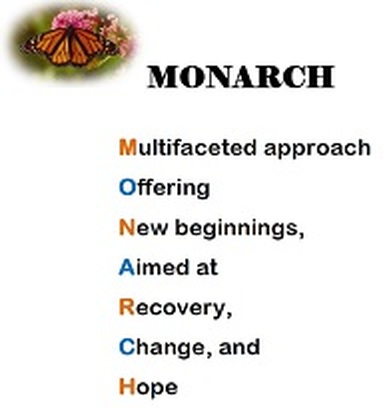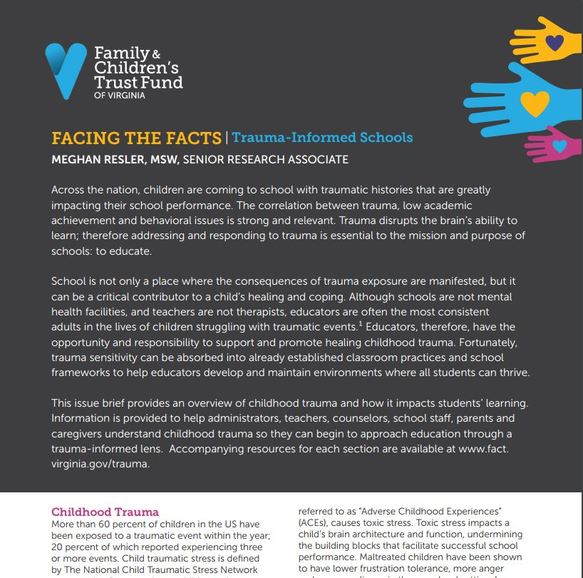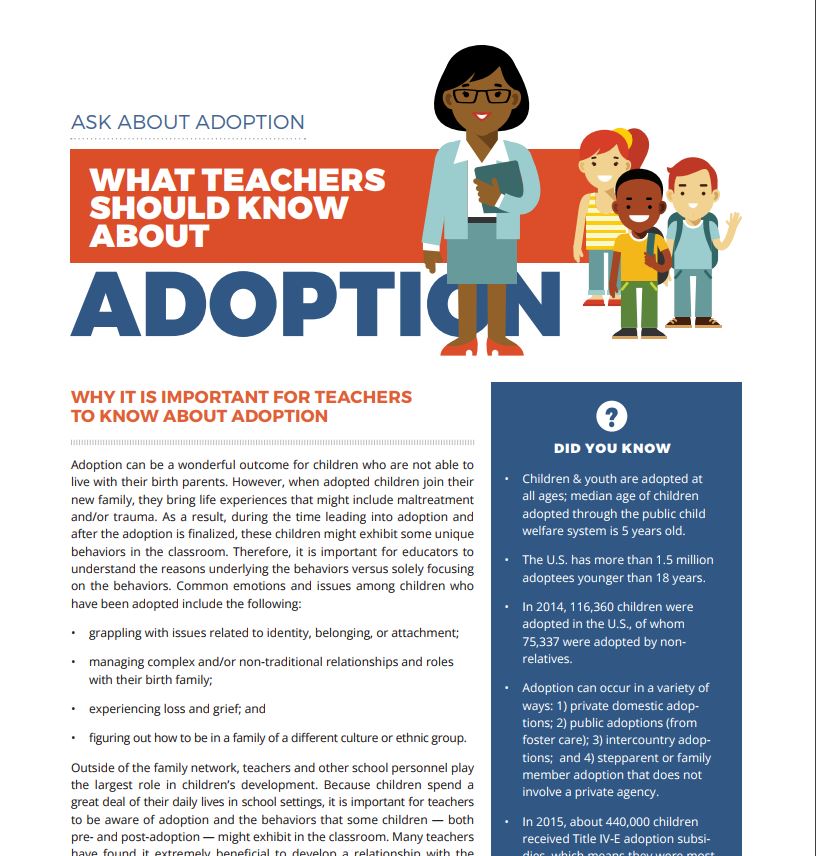Clara B Ford's trauma informed teaching model has been recognized nationally as a best practice.
What Teachers Should Know About Adoption
Trauma Informed Teaching Research Fast Facts
History of trauma can manifest itself in the classroom in several ways:
- Internalized and externalized behaviors
- Inability to self-regulate
- Inappropriate boundaries
- Inability to cognitively process information
- Inattentiveness
- Need for constant redirection
- Need to move
- Unexpected reactions to triggers
Court-involved students are/have:
- Less likely to do their homework
- Lower scores on standardized achievement tests
- More than twice as likely to fail a grade
- Assigned to special education services with greater frequency
- Higher discipline referral rates, suspensions, and expulsions
- Lower GPAs
- Higher school absences
- Lower high school graduation rates
- Lower IQs
- Lower self-esteem
Maintaining safety, supportive connections, and management of emotions are critical objectives to ensuring classroom success
Teachers working with traumatized students reported
- School staff are rarely trained in their college curricula or in post-degree professional development to understand how to effectively work with traumatized youth
- Being uncertain about their roles
- Challenges associated with meeting student classroom needs
- Needing more skills and information
- Needing more support
Result of Impact of Trauma Informed Teaching Professional Development on students:
- In the pilot year, there was a significant difference in the pre-test (M= 22.70, SD= 10.31) and post-test (M= 20.16, SD= 9.39) scores on the Child Report of Post-traumatic Symptoms (CROPS); t (69) = -2.53, p < .05, r = .30.
- For years 2012-2015, there was a significant decrease in CROPS pre-tests (M= 37.60, SD= 14.47) and post-tests (M= 27.92, SD= 17.95) scores for post-traumatic stress symptoms; t(108) = 6.07, p < .01, r = 0.60.
- Students described their teachers and school staff much more positively (e.g., supportive, caring) than students at the comparison school (e.g., disrespectful, uncaring)
- In the second year, students reported moderate to high levels of perceived teacher support, school involvement, and school attachment during the intervention period and increases in school attachment were associated with decreases in students’ trauma symptoms.
- In the second year, students also reported low levels of social support from classmates, which was associated with significant increases in students’ trauma symptomology. This may indicate a need for more peer-to-peer intervention and modeling of positive peer behavior.
Rationale for need for alternative to suspension: Implementation of the Monarch Room:
- Out of School Suspension is the most commonly recognized method of addressing conduct infractions in middle and high schools across the country
- Disproportionately impacts students of color, special education, and court-involved students.
- There are over 3 ¼ million students suspended annually across this country – with over 100,000 of these in Michigan
- 7% of the entire school population in Michigan misses at least 1 school day/year due to suspension/expulsion – a figure that has doubled since the 1970s
- Actual % are higher as in-school suspension statistics are not tabulated nationally
What is the Monarch Room?
- Separate room
- Facilitated by trauma-informed professionals
- Available all day
- Incorporates sensory-motor interventions
- Short-term: goal is to return to class in 10 minutes
- Seen as a support system; not punitive intervention by either staff or students
- Extensive data is collected and analyzed weekly and monthly
Results of Monarch Room Intervention Since Implementation
- Only 270 (38%) of the student body ever used the Monarch Room intervention
- Mean use was 10.36 visits over the observation period (or 5 visits per academic year)
- Students who experience multiple stays in the residential treatment center were significantly more likely to use the monarch room than those who only experience one stay in residential treatment.
- The odds of having a history of suspensions/expulsions are 4.2 times more for students who have experienced multiple stays in the residential treatment center than for students who only experienced a single stay
- Ninth graders seem to be the highest users of the Monarch room intervention (54%)
- 48% CBF students are enrolled over multiple years.
- 35 total suspensions experienced over the course of the observation period, 32 occurred in year 2. Many of the students who experienced these suspensions were repeat offenders. Eleven students in the sample experienced 2 or more suspensions during year 2, accounting for a total of 24 suspensions, or 75% of all suspensions give that year. The number of suspensions significantly decreased in year three of the observation period, with only 3 suspensions given, and none of these students who experienced a suspension in that year were given more than one.
- Students who experienced an average of 10 or more absences over the reporting period were more likely to have a history of suspension/expulsions than students who experienced an average of less than 10 absences.
- All of the students who experienced suspensions/expulsions were exposed to the Monarch room intervention prior to being suspended/expelled; attempts are made by the school to address behavioral concerns before resorting to putting students out of school
- In year 2014-2015, students had a significant increase in minutes spent in the Monarch room over the course of the school year, demonstrating that students and teachers utilize this resource—from an average 24.79 minutes in the first three months of school to an average of 53.00 minutes during the middle three months of the school year.
- Only 2 of the students in this sample received an out-of-school suspension
- Students viewed the Monarch room as a positive resource that improves their functioning, and suggested that students take greater ownership over their behavior
Qualitative Student Response
Ways that Students Respond to a Negative Mood
“Sometimes I do [fight]. When I’m in a bad mood, if someone that I don’t like comes in the puzzle and just rubs me the wrong way, I feel like fighting them, that’s just how I am.”
“…I give them [other students] the same reaction I would give anybody else on the street because you’re my age, you’re close to my age, and you think that you can just come to me any kind of way. I have a low tolerance for BS, so I come to them how they come to me…I become very disrespectful and very aggressive.”
Things that Impact Students’ Moods
Students explained that their classmates greatly impact negative changes in their moods.
“Like this morning, perfect example, I got called ‘crazy’… I got really upset because society has already labeled me as crazy because of the mental illness I’ve already been labeled with. So I’m already labeled as crazy, I don’t want to hear my peers call me ‘crazy’ because that’s something that triggers me. Because I’m not crazy. I’m very smart, very intelligent, very insightful, and that’s just who I am. But people see my outer self— they don’t get a chance to get to know me as a person.”
“Say for instance, you were taken away from your mom and her rights were terminated. They [peers] will say, ‘Oh, that’s why you can’t live your mom’, ‘Your mom’s B-word’, ‘Your mom’s a crack-head’, or something like that…that’s a trigger…”
Student Perceptions of Their Trauma Trained Teachers
“Some of them [teachers] are more supportive and ask you if you need to go to the Monarch Room, ‘Do you want to step out in the hallway and talk to me?’, ‘Is there someone you would like to talk to’, stuff like that or ‘Just let me know if you need anything’ and stuff like that. Some of them are supportive.
“A lot of our teachers have been here for at least two years and we have maybe one or two that have just started this year but they got the hang of it, that we’re placement kids, and they know that we have issues. So they try not to say something [negative] because they never know what’s going on with us…”
Student Perspectives on the Impact of Monarch Room
“In the Monarch Room, she [MR staff person] kinda gives you space to yourself, and then she asks you, ‘Are you ready to talk? Do you want to talk?’. Other than that, she just gives you space…there’s puzzles in there to help get your mind off of different things…and then she allows you to take that stuff into other classrooms too. So you got people, like me, who always gotta move….you can concentrate on that [puzzles] and it helps you stay still.”
“I feel like, in some cases, it’s a good thing to have the Monarch Room here in this specific environment…the girls that are disruptive and got attitudes and just set a negative mood in the room can get away from everybody…don’t nobody want to be around that. At the same time, they [disruptive girls] are not learning, they’re not in class, they’re not doing no work. So sometimes it’s just like you need to just give them a limited time to be in there [the MR], and tell them to get their self together. Do whatever they need to do for fifteen, twenty minutes, and go back to class.”
“Sometimes I do [fight]. When I’m in a bad mood, if someone that I don’t like comes in the puzzle and just rubs me the wrong way, I feel like fighting them, that’s just how I am.”
“…I give them [other students] the same reaction I would give anybody else on the street because you’re my age, you’re close to my age, and you think that you can just come to me any kind of way. I have a low tolerance for BS, so I come to them how they come to me…I become very disrespectful and very aggressive.”
Things that Impact Students’ Moods
Students explained that their classmates greatly impact negative changes in their moods.
“Like this morning, perfect example, I got called ‘crazy’… I got really upset because society has already labeled me as crazy because of the mental illness I’ve already been labeled with. So I’m already labeled as crazy, I don’t want to hear my peers call me ‘crazy’ because that’s something that triggers me. Because I’m not crazy. I’m very smart, very intelligent, very insightful, and that’s just who I am. But people see my outer self— they don’t get a chance to get to know me as a person.”
“Say for instance, you were taken away from your mom and her rights were terminated. They [peers] will say, ‘Oh, that’s why you can’t live your mom’, ‘Your mom’s B-word’, ‘Your mom’s a crack-head’, or something like that…that’s a trigger…”
Student Perceptions of Their Trauma Trained Teachers
“Some of them [teachers] are more supportive and ask you if you need to go to the Monarch Room, ‘Do you want to step out in the hallway and talk to me?’, ‘Is there someone you would like to talk to’, stuff like that or ‘Just let me know if you need anything’ and stuff like that. Some of them are supportive.
“A lot of our teachers have been here for at least two years and we have maybe one or two that have just started this year but they got the hang of it, that we’re placement kids, and they know that we have issues. So they try not to say something [negative] because they never know what’s going on with us…”
Student Perspectives on the Impact of Monarch Room
“In the Monarch Room, she [MR staff person] kinda gives you space to yourself, and then she asks you, ‘Are you ready to talk? Do you want to talk?’. Other than that, she just gives you space…there’s puzzles in there to help get your mind off of different things…and then she allows you to take that stuff into other classrooms too. So you got people, like me, who always gotta move….you can concentrate on that [puzzles] and it helps you stay still.”
“I feel like, in some cases, it’s a good thing to have the Monarch Room here in this specific environment…the girls that are disruptive and got attitudes and just set a negative mood in the room can get away from everybody…don’t nobody want to be around that. At the same time, they [disruptive girls] are not learning, they’re not in class, they’re not doing no work. So sometimes it’s just like you need to just give them a limited time to be in there [the MR], and tell them to get their self together. Do whatever they need to do for fifteen, twenty minutes, and go back to class.”




